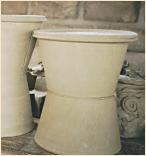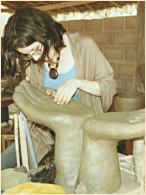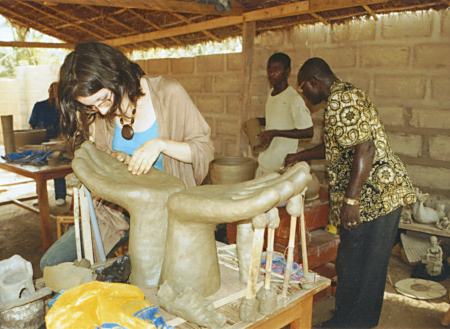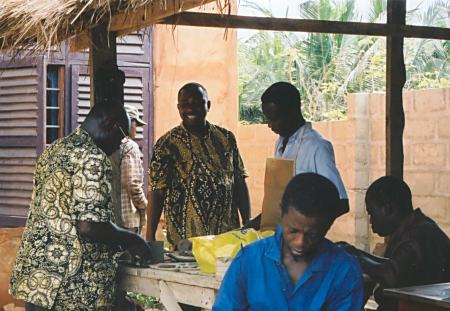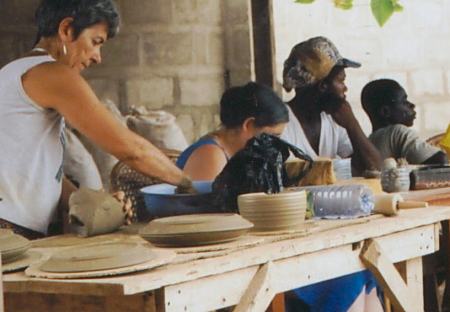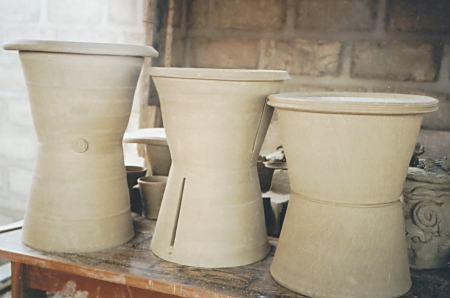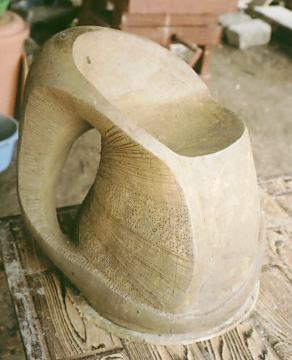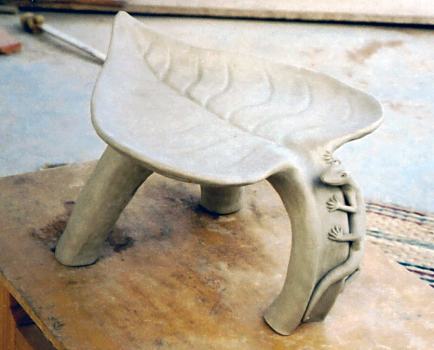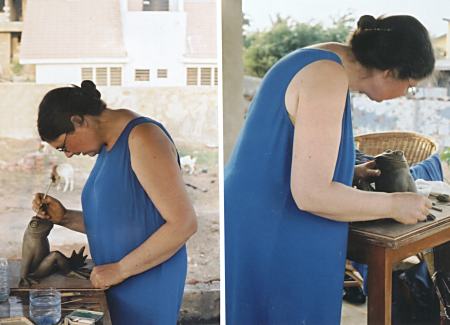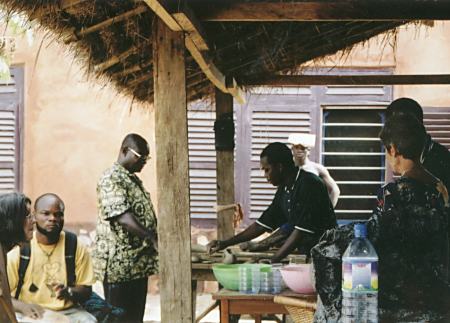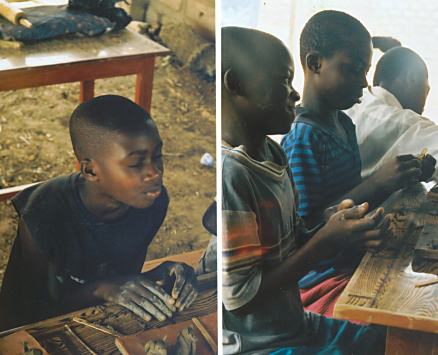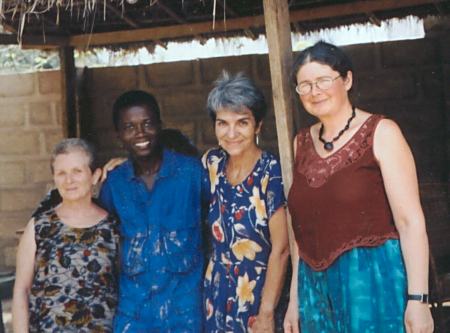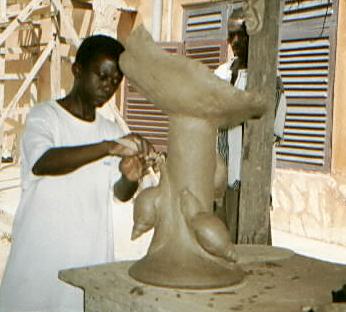Ceramic Furniture Workshop, February 2003
This workshop was a continuation of the ceramic furniture workshop started in August 2002.
Aba and Sammy continued where the last one left off with the help of Jennifer Robinson (France), Helen Graham (France), Gigliola Caneschi (Venezuala) and Francis Boeteng (Ghana).
Ghanaians attending ranged from a ceramic student to professional potters, teachers and the retired head of a university ceramics department.
As usual two days is not enough time to fully develop the theme, but interest was high and several of the participants returned on their own time to complete work.
Workshop dynamics differ for many reasons. This time most of the samples were wheel thrown as opposed to August when everything was hand built. What stayed the same was that people worked in small groups to complete a sample and the results are exciting.
In August Barbara Allen (USA) will come back to work with Aba and the Ghanaian potters. These workshops will continue as long as there’s an interest, and judging from past participation that will be for a long time. One measure of the workshops success was shown by the neighborhood workmen. Carpenters, masons and other laborers would drift in and start working with us on their breaks. And some neighbors were curious enough to wander in during the kiln firing.Not unusual in itself, but we fired in the night until 5 a.m.
We also conducted a few informal classes with the neighborhood children. They continue to be enthusiastic.
Gigliola's report on the workshop
The most important aspect of my stay in Ghana at Aba's house was the human quality of the people I met there. Aba's house is like a magnet , there is a permanent coming and going of children, neighbors, local workers, artists coming to show their work and share a talk with Aba and her friends, visiting artists from other countries, local craftsmen and everybody is open to listen to somebody else's experience and the atmosphere is very light and joyful.
The idea of the workshop was to continue the work done by Barbara in august, however the participants being different persons we worked on new ideas. Each person made several sketches and a maquette of one of the ideas and then the group chose three projects to work on collectively, due to time limitations. I had to work on those projects during the following days in order to complete them and Emmanuel and Edward came back several times to help. None of these projects was fired as they required a very slow drying process. I was quite impressed by the level of training and knowledge of the participants in the workshop, their main interest or worry I should say, was the difficulties in developing glazes as they are not produced locally and raw materials are not easy to find. Finding white clay is another problem. Anyway we decided to make some glaze tests for cone 4, assuming that with Kaolin, Feldspar, Calcium Carbonate and Dolomite which are produced locally we should be able to develop a white glaze. We worked on a series of combinations of those four materials in different proportions using a spoon for measuring as no scale was available. I also made three clay tests mixing white clay and red clay in different proportions to see if we could develop a body for middle range temperature.
 Sammy came to help with the firing which was rather problematic, we started very late in the
morning because of the rain and because we had to fetch the gas cylinder. The pieces were not thoroughly dry so we started a very slow fire with the kiln half open, increasing little by little the
gas pressure but keeping the gauge on 0. After twelve hours we closed the kiln completely and started increasing the pressure up to 1,5. We had a lot of smoke in the first stage of the firing because
of the design of the burners which doesn’t allow a primary air control, so that they don’ t produce a good combustion unless you have a lot of pressure. When we started having colour there was no
way of having an oxidizing or neutral atmosphere, the kiln doesn’t have a chimney and there isn’t enough draft, so we had all the time a flame at the spy hole. At 5 o'clock in the morning we decided to
stop the firing and we had reached cone 06 only, so none of the tests melted. In order to get more temperature some adjustments should be done like adding a small chimney and designing a way of
controlling the primary air intake in the burners, so that combustion is more efficient, this is very important considering that gas is quite expensive. I felt frustrated at not having been able to reach cone 4,
so I brought back samples of the raw materials and the clays and I will make the tests in my workshop with my students.
Sammy came to help with the firing which was rather problematic, we started very late in the
morning because of the rain and because we had to fetch the gas cylinder. The pieces were not thoroughly dry so we started a very slow fire with the kiln half open, increasing little by little the
gas pressure but keeping the gauge on 0. After twelve hours we closed the kiln completely and started increasing the pressure up to 1,5. We had a lot of smoke in the first stage of the firing because
of the design of the burners which doesn’t allow a primary air control, so that they don’ t produce a good combustion unless you have a lot of pressure. When we started having colour there was no
way of having an oxidizing or neutral atmosphere, the kiln doesn’t have a chimney and there isn’t enough draft, so we had all the time a flame at the spy hole. At 5 o'clock in the morning we decided to
stop the firing and we had reached cone 06 only, so none of the tests melted. In order to get more temperature some adjustments should be done like adding a small chimney and designing a way of
controlling the primary air intake in the burners, so that combustion is more efficient, this is very important considering that gas is quite expensive. I felt frustrated at not having been able to reach cone 4,
so I brought back samples of the raw materials and the clays and I will make the tests in my workshop with my students.
 My personal reflections after the workshop are that the people that work with clay in Ghana are
overwhelmed by the difficulties in finding the materials and covering the costs of production on one side and on the other side I think there is a certain conceptual confusion as to what type of ceramic one should create.
I had the feeling that ceramists feel the need to make a clear difference between traditional pottery and art, and that traditional pots are usually considered too simple, so that artistic pots should be more complex
and should reflect personal expression, should have a lot of colour, and should comply with the expectations of foreign buyers.
My personal reflections after the workshop are that the people that work with clay in Ghana are
overwhelmed by the difficulties in finding the materials and covering the costs of production on one side and on the other side I think there is a certain conceptual confusion as to what type of ceramic one should create.
I had the feeling that ceramists feel the need to make a clear difference between traditional pottery and art, and that traditional pots are usually considered too simple, so that artistic pots should be more complex
and should reflect personal expression, should have a lot of colour, and should comply with the expectations of foreign buyers.
The other important aspect is that there is a lot of interest in what potters do in other countries but practically very little access to information. I had taken with me some slides but as no projector was available it was impossible to use them as a starting point for conceptual discussion. I tried to emphasize the fact that for western ceramicists African traditional pottery is a source of inspiration and that maybe it would be worthwhile to try to work with what is available and find a personal expression within the local limitations and I thought that the sculptural work Francis presented at the Alliance Française corresponded exactly to that concept. Besides a majority of the participants seemed more interested in sculpture than in functional ware so glazes shouldn’t be such a problem. For further research I would suggest working with different clays and natural pigments in order to develop several bodies, for low and middle range firing. I think that a line of slips could be developed using the same materials . I also suggested trying a self setting body which is a mixture of clay and cement that can be modeled and doesn’t need to be fired and can be painted in different ways and is very convenient for large scale work. For functional ware I will make the tests and I think a white glaze can be developed for cone 4 and natural pigments could be used for decoration. On the esthetic side it would be interesting to open discussion, using slides or magazines, on different ways of dealing with clay in the work of contemporary artists.
-- Gigliola Caneschi
Jennifer's report
It all started in the summer of 2001. I was exhibiting at a potters fair at Moulins la Marche in the north of France, where each year they invite two guest potters/ceramic artists from a different country. That year they had invited Francis Boateng and Samuel Lovi, both from the Accra region of Ghana. While there Francis said "And if there are any potters who would like to make a return trip to Ghana......." . Well, there was me. Because of other commitments on both my time and money I couldn't go straight away but said I would go at the beginning of 2003. Francis admits to not really believing that I would ever get there, but I did, My eighteen year old daughter Helen came with me as she is currently working with me learning ceramics. Francis and I planned to work together for several weeks then hold a joint exhibition of Francis´ sculptures of people, and my animal figures.
Francis also told me about this wonderful person, Aba, and about Aba House, and suggested we participate in a ceramic furniture workshop that would take place while I was in Ghana. I thought it was a good idea, though the idea of making ceramic furniture had never really entered my head before. Aba arrived shortly after we did, and also offered me the possibility of doing some of my work towards the exhibition there.
 Working part of the time at Aba House was an excellent idea. I worked mostly up on the flat roof terrace, under the shade of a small thatched
roof from where I could see what was going on all around, and of course everyone could see me too. Seeing me there often, the neighbours would say hello to me, or wave, and the children would shout their greetings.
Curiosity brought some of them to see what I was doing, and some of them came back several times to see how my work was progressing. I watched one of them with interest, Salim, a cement artist, who was creating murals on
the walls of the property next door. When we in turn went to see his work he explained to us what he was doing, and the traditional meaning of each scene. He was one of the people who came at the end of the day when we held
the workshop. He had never tried making things with clay before, but after a few tips on technique he was good at it and enjoyed it too.
Working part of the time at Aba House was an excellent idea. I worked mostly up on the flat roof terrace, under the shade of a small thatched
roof from where I could see what was going on all around, and of course everyone could see me too. Seeing me there often, the neighbours would say hello to me, or wave, and the children would shout their greetings.
Curiosity brought some of them to see what I was doing, and some of them came back several times to see how my work was progressing. I watched one of them with interest, Salim, a cement artist, who was creating murals on
the walls of the property next door. When we in turn went to see his work he explained to us what he was doing, and the traditional meaning of each scene. He was one of the people who came at the end of the day when we held
the workshop. He had never tried making things with clay before, but after a few tips on technique he was good at it and enjoyed it too.
At home I work with two different clays, one a very fine white earthenware, the other a grogged white clay, but in Ghana white clay doesn't really exist. Francis had been liaising with the Centre for Scientific and Industrial Research to try to produce a white body. We tested the only thing on offer but it was extremely short and needed quite a high firing temperature, and wasn't very white either. I settled for a red earthenware body which was fairly plastic but not at all grogged, which made larger pieces difficult. I thought about furniture, and in preparation for the workshop I made three small size models of stools, two of which I made full size. The third one I decided wouldn't be possible to make and dry successfully given the climate and the fact that I was working with an untried, ungrogged clay, (but I hope to make it here in cooler, damper France one day).
 We managed to successfully dry the two stools and transport them to Francis´ workshop, carefully packed in boxes of sawdust
for biscuit firing. Francis´ driver Kwame did a good job of driving slowly and carefully, avoiding as many potholes and bumps as possible, while Helen and I sat in the van with the boxes cradled gently on our knees. They
survived firing too and came out of the kiln just in time for the workshop, arriving still warm in the afternoon. Of course we promptly tried them out, and they were quite comfortable too. The workshop was really interesting,
with a good mixture of ideas and techniques, and time to discuss ideas and problems while we ate the delicious lunch that Talktrue had prepared for us. Two days is not long enough, but it is difficult to make it longer as
some of the participants came a long way, and they had other work commitments too. Finance is another problem. Being an artist or craftsperson is not easy in Ghana, with a sliding economy and a lot of
uncertainty, art is a luxury affordable by only a few, even though there is a big tradition of art there. Most artists have to turn towards the export market to make a living, and often the importers are only interested in a
very limited stereotype of what is "African" art. Of course they also want to bargain hard and squeeze the price till it is virtually impossible to make more than a pittance. Perhaps one day the exploitation of the Third
World by the richer more developed countries will cease, but we're all a long way from it yet, and should be ashamed of our behaviour.
We managed to successfully dry the two stools and transport them to Francis´ workshop, carefully packed in boxes of sawdust
for biscuit firing. Francis´ driver Kwame did a good job of driving slowly and carefully, avoiding as many potholes and bumps as possible, while Helen and I sat in the van with the boxes cradled gently on our knees. They
survived firing too and came out of the kiln just in time for the workshop, arriving still warm in the afternoon. Of course we promptly tried them out, and they were quite comfortable too. The workshop was really interesting,
with a good mixture of ideas and techniques, and time to discuss ideas and problems while we ate the delicious lunch that Talktrue had prepared for us. Two days is not long enough, but it is difficult to make it longer as
some of the participants came a long way, and they had other work commitments too. Finance is another problem. Being an artist or craftsperson is not easy in Ghana, with a sliding economy and a lot of
uncertainty, art is a luxury affordable by only a few, even though there is a big tradition of art there. Most artists have to turn towards the export market to make a living, and often the importers are only interested in a
very limited stereotype of what is "African" art. Of course they also want to bargain hard and squeeze the price till it is virtually impossible to make more than a pittance. Perhaps one day the exploitation of the Third
World by the richer more developed countries will cease, but we're all a long way from it yet, and should be ashamed of our behaviour.
One of the best things about our stay in Ghana was the people we met. I have visited Africa twice before, having spent a total of 4 months cycletouring in Kenya and Uganda when Helen was a small child, but we were "just tourists", always moving on. It is a completely different experience to work with people who don't regularly work in the tourist trade, and to continue to work with them till the end of the project, with the mutual exchange of ideas and culture that this brings. This includes not only locals but Aba and Gigliola, whose culture isn't the same as mine, though it is more subtly different. We also met friends and relatives of the people we worked with, and the contact continues with some of them becoming our good friends. Of course I only learnt a very small part of Ghanaian culture in the few weeks that I was there but I would like to learn more. The Ghanaians are the most welcoming friendly people you could want to meet, and they have a remarkable acceptance of all the many and varied problems that life throws at them regularly, and put their faith in God to sort it all out. Women in Ghana are quite powerful and independent compared to in some other African countries, but this doesn't stop the men being courteous and gallant towards them. As a visitor it is difficult to be allowed to do things like carrying shopping yourself, you are their guest. They have as many misconceptions about life in Europe as we have about theirs, women potters here regularly wedge their own clay, and load their own vans, so it was interesting to "swap stories". My clay doesn't arrive in a dry heap tipped outside my gate from a lorry, needing washing and redrying to get rid of the stones and grass before I can use it!
I hope the series of furniture workshops continues as there are a lot of ideas still to be explored. One thing I am sure of, like many others - I will be back again before long, even if you don't ever go anywhere in a straight line and nothing ever happens how and when you expected it to.
-- Jennifer Robinson
![]()



